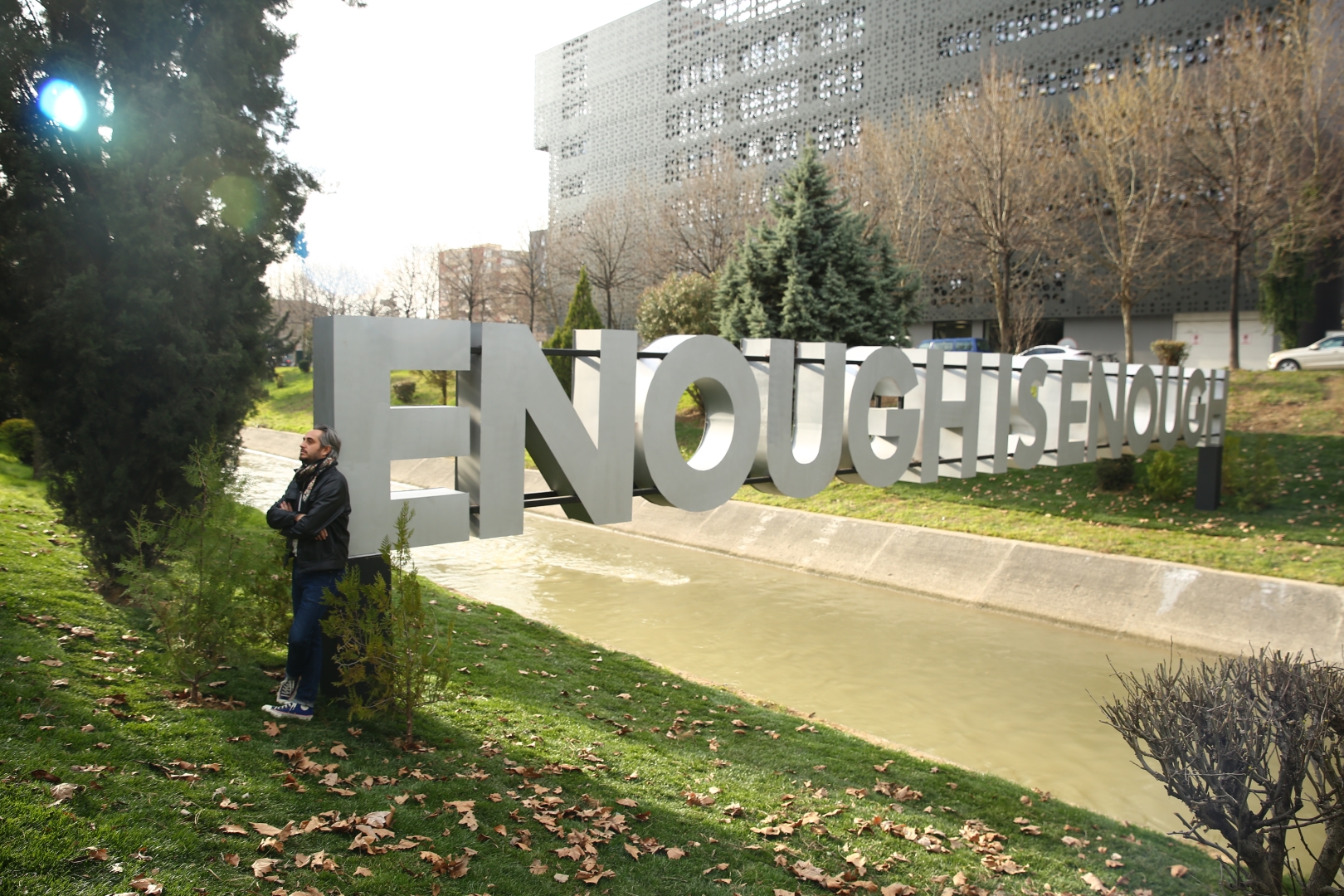This Friday, March 19th, 2021, Harabel Contemporary Art Project inaugurated the public art installation “Enough Is Enough” by artist Alban Muja.
This artwork is part of an ongoing project of Harabel focused on giving to public spaces contemporary art installations, aiming to set a close interaction between the public and contemporary art, as well as to create an open dialogue between urban space and art.
“Enough is Enough” is the second artwork that takes part in this project that has started last year in November, with the inauguration of “The Calligraphy” by Adrian Paci.
The concept
This oeuvre, the first of its kind for the contemporary artist Alban Muja, is an iron sculpture, which connects the two banks of the Lana River in one of the most crossed areas of the capital. The work, – a sculpture more than an installation -, consisting of the forming letters of the phrase Enough is Enough, is about 15 meters long and each letter is 1.8 meters high. Nevertheless, it carries a discreet monumentality, as it is not visible from the roads on either side of the river that it connects, but can only be seen by pedestrians on the nearby bridges, or by those seeking to look at it among the surrounding vegetation. This placement is certainly intentional: the unification of the two sides is a rhetorical gesture, but also a parallelism that responds to the truth of two nations connected since always and forever; on the other hand, the almost hidden placement of a monument of such large dimensions, calls again another great truth: that of the Albanian hospitality of the exodus of Kosovo during the war, great but elegantly silent.
The themes of memory, the Kosovo war and the material representation of pain are continuous subjects in Alban Muja’s artistic research. Enough is Enough, is in its shape unusual for him, but in its essence is a continuation of the discourse that Muja initiates in his work, confronting the public with major issues, like: war, emigration and division, but at the same time with the importance of humanistic values, such as collective aid, or being there for others during refugee crisis.
The birthplace is the secure starting point of Muja’s work, same as the war, as a lived truth of his, but Enough is Enough is not only a monument of Kosovo’s relationship with Albania, but also an echo of the situation of every refugee in the world today. From this perspective, Enough is Enough is a political act that surpasses the territory where it is born, a rebellion towards today’s socio-political models, which tend to emphasize more on (territorial) borders than human life and the universal right to security and stability. The intention of this work is not the recollection of war, but the approach with its consequences to the affected people and the problematics of power as a purpose.
Enough is Enough is a work of public art by the artist Alban Muja, which originates from the statement made by President George Bush during his visit to Tirana in 2007: “At some point in time, sooner rather than later, you’ve got to say enough is enough, Kosovo is independent!”, giving a clear message to all international politics, but also reminding once again the linked fates of Kosovo and Albania.
Enough is Enough approaches as a historical memory after two decades, and as such it may seem belated, but it is precisely the evidence of a slightly changing world, almost an artifact of the great refugee crisis that the Balkans experienced and that apparently had little impact on international political behavior, as the world constantly sees the birth and the expansion of acute areas of humanitarian crisis. In this context, Enough is Enough comes not only as the answer that the American President gave to Kosovo’s independence status, but also as a questioning of the long-term relationship between power and human freedom.
(Curatorial text by Ajola Xoxa)
About the artist
Alban Muja (born 1980) is a Kosovan contemporary artist based in Berlin and Prishtina. Influenced primarily by the social, political and economic transformation processes in the wider surrounding region, he investigates history and socio-political themes and links them to his position in Kosovo today.
Selected exhibitions include: Ludwig Museum, Budapest; Maxxi Museum, Rome; 3rd Industrial Art Biennial, Istria, Croatia ; MOMus Experimental Center for the Arts, Thessaloniki; Kumu Art Museum, Tallinn; Guangdong Museum of Art; Museum Of Contemporary Art – Skopje; MeetFactory, Prague; Forum Stadpark, Graz; James Gallery, New York; City Art Gallery of Ljubljana; Zhejiang Art Museum, Hangzhou; Museum of Fine Art, Split; Trieste Contemporanea; Museum of Modern and Contemporary Art, Rijeka; Zachęta National Gallery of Art, Warsaw; ‘2ndBiennial of Contemporary Art in the Atomic shelter in Konjic, BiH; Škuc Gallery, Ljubljana; National Gallery of Kosovo; Museum of Fine Art, Split; Gagosian Gallery, Beverly Hills; Slovak National Gallery; Staatliche Kunsthalle, Baden-Baden; 28th Ljubljana Graphic Biennale; nGbK, Berlin; National Gallery of Arts, Tirana; Cetinje Biennale and others.
Muja in 2019 represented Pavilion of Republic of Kosovo at the 58 Venice Biennale with project called “Family Album”.









